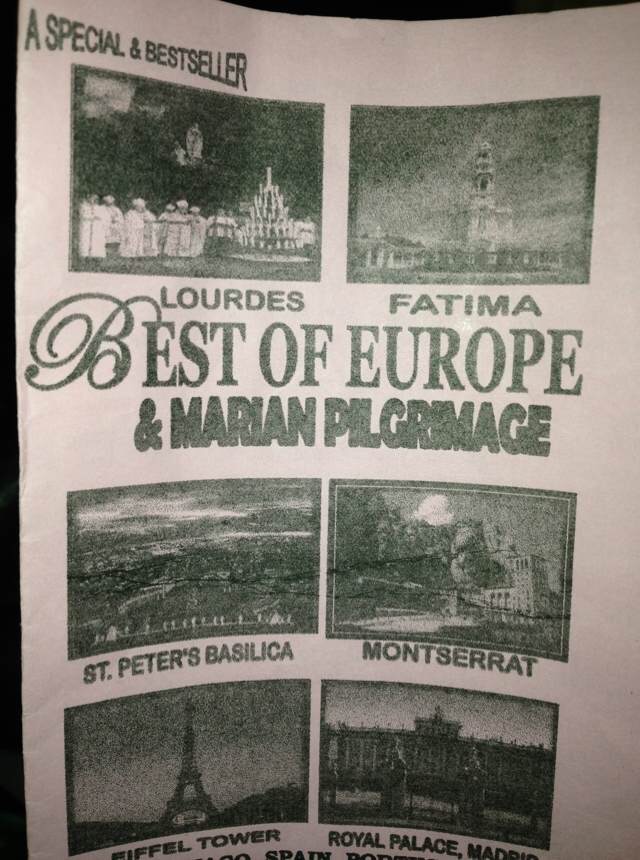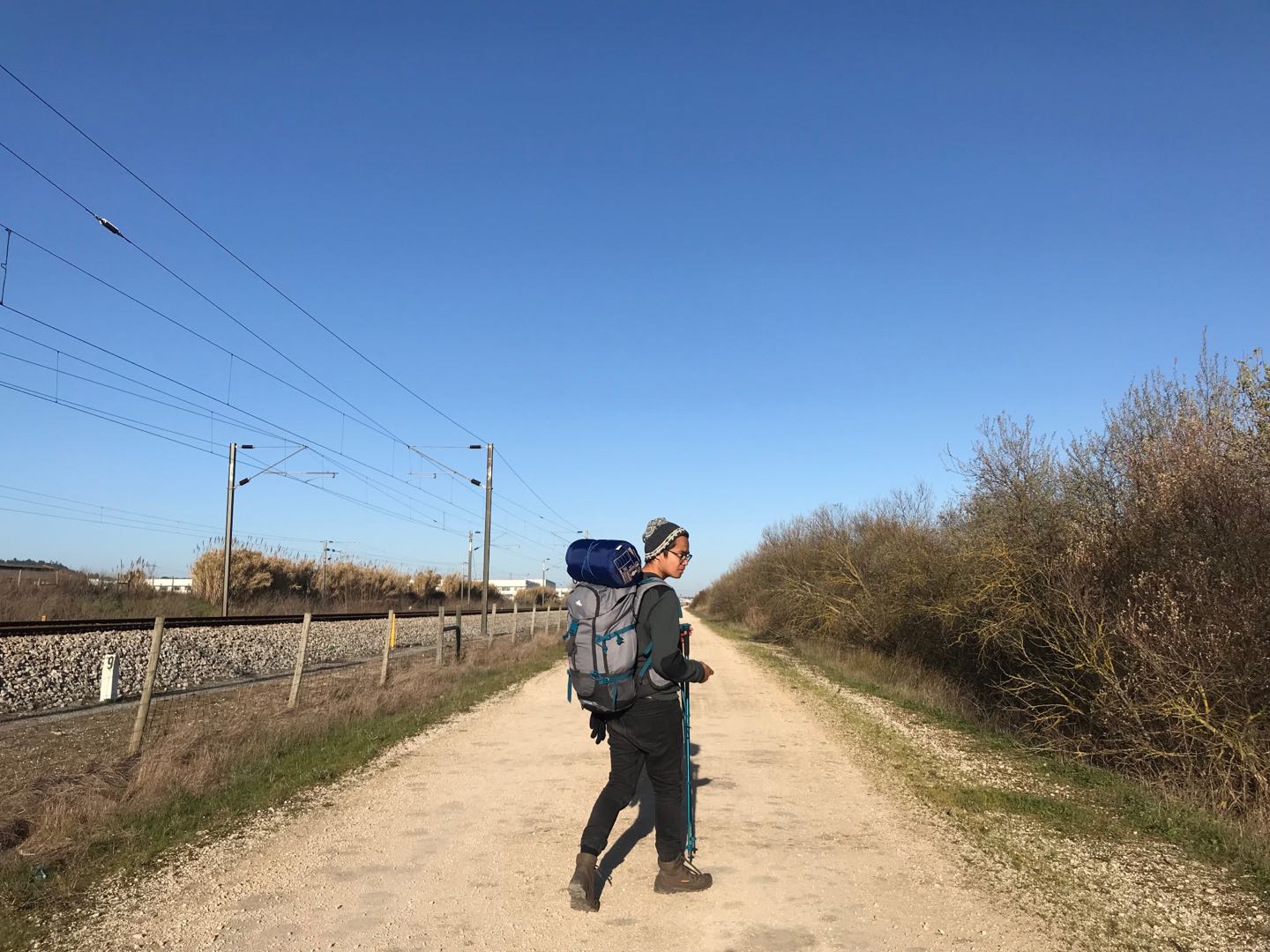My body was confused experiencing the warmth of the sun against the still-chilly spring air on the outskirts of the central Portuguese city of Santarem. Walking over 55 kilometers in two days was no joke and it had already worn me down. But the millennial me was still ready to snap photos even though my hands were so shaky.
I took a selfie at the 50-kilometer milestone of the Caminho Fatima (the pilgrim’s “Road to Fatima” in Portuguese), halfway to the town of Fatima. I had already lost count of how many milestones and route marks I had photographed, but there were more to go — on the arduous mountainous path of Day 3. With sore feet. With ankles that almost had open wounds. Thank God, I had brought blister patches.

The next stop was three more hours — or roughly 14 kilometers — away, so I needed to rest my feet and readjust my backpack since its weight had already been affecting my pace and stability. And the remaining part of the day would be the most demanding leg of the pilgrimage due to rocky descents and a subsequent uphill trek to reach an archaeological museum, where I would spend the night.
To be fair, I had less than 15 kilograms of content: a sleeping bag, toiletries and a first aid kit, a raincoat, and clothing good for four days. On paper, this was optimal. In reality, it was still too much. But I was glad I bought a new hiking backpack.
Just three days before, I met a volunteer from an association helping Fatima pilgrims, for some hiking advice. He had no qualms about my physique and mental preparedness, but he frowned upon learning I was intending to use my office backpack on the 110-kilometer journey from Lisbon to Fatima. He implored me to buy a new backpack.
“Our walk depends on how much weight we carry,” he explained, “and you would do your back justice if you use a proper backpack.”
Before we said our goodbyes, he handed over a “passport” which would certify I undertook – and eventually would finish – the pilgrimage. He also informed me I was the first Filipino who had signed up with their association for the religious trek, which gave me a sense of achievement at first but pressure thereafter.
Many Filipinos have an immense devotion to the Virgin Mary, with many local churches named in honor of Our Lady of Fatima, the title based on her reported apparitions in that town in 1917. I also grew up attending weekly “block rosary crusades” where families would bring the image of the Lady from house to house while singing hymns and praying the Rosary. The experience itself is calming, but it also showed how faith can bring our community closer.

Never did I think that I would eventually find myself scrabbling over the items to bring for my pilgrimage. I was truly excited to take on that spiritual adventure, but then I needed to free my mind from the events that had weighted me down on my Beijing journey.
I started the pilgrimage at Se de Lisboa and then took the train to the next major town, Vila Franca de Xira, cutting 20 kilometers from the official route length because I had less than a week left on my break. From the town, I began searching for the blue arrows that marked the route.


As the backpack helped maintain my posture, I strutted across the fields and did not feel I had already walked for over 15 kilometers. Then as I reached the eight-kilometer footpath parallel to the train track, I started asking myself if I would still be able to walk the remaining 80 kilometers when the easy way was just in front of me.
Then in that solitude during sunset, my mind began to wander. It took me a long way to achieve my childhood goal of making a pilgrimage to Fatima. And along that journey, I experienced events that tested my mental fortitude and encountered people who challenged my values.

It was already dark when I reached the next stop in the town of Azambuja, where I met Emanuele, an Italian pilgrim bound for Santiago de Compostela. He would be my travel companion on Day 2 towards Santarem.
While Emanuele’s pilgrimage partly was religious in nature, he mainly did it to help his left leg recover faster from an injury. Along the way while talking about our experiences, we came across a middle-aged Dutch Caminho hiker, who brought a small backpack and only two pairs of clothing. We were dumbfounded at the idea that the Dutch hiker was also a beginner, but his pace was three times faster than ours.
Emanuele and I arrived at Santarem just before sunset. He was almost knocked out, but I encouraged him to walk still to keep our momentum. At the albergue (pilgrim hostel), we met two more hikers who took the Camino Santiago on as a physical challenge and both of them shrugged off the spiritual nature of my trek.
The following morning, Day 3, Emanuele and I parted ways as he took the eastward route of the Camino Santiago while I took the north road to Fatima. I struggled to maintain balance on the downhill path as my backpack exerted pressure on my already sore feet. At the mountain pass, I sang aloud to break the remaining two-hour trek into three to four minutes of walk, since 15 minutes equaled another kilometer toward my destination.
I reached the museum just as a student group was wrapping off their tour. With all formalities of signing forms done and dinner munched on, I went to my bunk bed only to find out I would be the only person staying in the sleeping quarters overnight.
Photos: Andy Penafuerte III

Pingback:A Passport to Adventures: A Decade of Journeys - coolkidandy
Pingback:2020 Vision: Focus on What Matters - coolkidandy